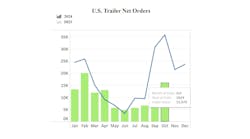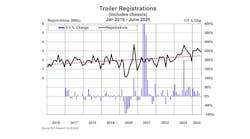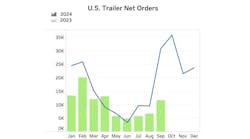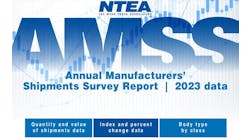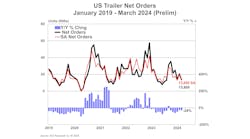The sky seems to be falling, but Latin-Kasper says municipal government and export markets will continue to thrive
As Steve Latin-Kasper surveys the economic landscape in America, the picture is rather disconcerting. There is no way to avoid the reality: It could be pretty nasty for the rest of this year and 2009.
And yet there is hope for the astute business owner, according to the National Truck Equipment Association's (NTEA) market data and research director.
Latin-Kasper, in his presentation, “Truck Equipment Market Outlook: Domestic and International” at the Business and Market Planning Summit in Dearborn, Michigan, said the municipal-government market was a refuge during the first three quarters of this year, and will continue to be.
“Those who have been in that market, you've had a pretty good 2008, because they're buying a lot of trucks,” he said. “They had stable tax revenues and no reason to go below budgets. They're all sticking to their plans, and their plans have been to buy a fair number of trucks.
“Going forward, we know that nationwide, we have an infrastructure problem. There's a lot that needs to be done. That's true not just for highways and streets. It's true for water sewage facilities and other sources of utilities. A lot of them are old, and there's a lot of new building going on, and a lot more new building that's going to occur.
“This is a market you want to maintain a close association with. This is one of those few bright spots through the rest of this year. Tax revenue is going to fall off for state and local entities. They have a state constitution that prevents them from doing that. But the federal government is going to keep spending. There are a couple of other niche markets that are not looking bad. As bad as 2009 might be, there are going to be opportunities out there.”
Words of advice
Some other tips from Latin-Kasper:
-
Regardless of how slow business gets, hold onto critical personnel. Use the slow time for training, plant maintenance, and market research.
-
It is acceptable to let inventory build a bit. The heavy-duty pre-buy was expected to start in the fourth quarter.
-
Steel prices started falling in the third quarter. If possible, wait until the end of the year to buy steel.
-
“Spikes never last, but they're really painful while they're going on,” he said. “I can see it tapering off. Prices were going back down for sheet in July. We've seen the beginning of the end of the spike. Are they going to come back down as fast as they went up? As nasty as steel pricing has been, we've probably seen the end of it for a while. If you don't have to buy steel right away, don't. If you can hold off for two to three months, hold off, because prices are going to go down and you'll get a better deal.”
-
Search out export markets for your product — the sooner, the better. Because of the depreciation of the US dollar, there will never be a better time to find customers overseas.
“The US dollar is likely to appreciate — not because we're doing things right but because the rest of the developed world is doing things even worse than we are,” he said. “Currencies, especially the Euro, are going to depreciate against the US dollar. But it's not going to happen overnight. We can expect to see 2009 exports in this industry continuing to grow. That's another bright spot to think about in 2009. If you're already exporting, great. If not, do something about it. It makes a lot of sense in 2009 but even in the long run, diversification is a good idea. And if you're not exporting, that's a great way to diversify.”
The value of trucks, buses, bodies, and other truck equipment shipped to Russia in 2008 more than doubled over a year ago ($232 million to $480 million). Sales to China fell off from $323 million to $265 million, but it remains a good market.
“In Russia, there's a substantial aftermarket for all the things on their trucks,” he said. “Even if Russia does slide into a deep recession, they still have all those used trucks they've been buying that need to be serviced and get replacement parts for.
“Between 2006 and 2008, China rose 118% and Russia 153%. For now, I'm confident in saying these are going to remain good markets through 2009. If you're not there, you should be. In Asia, they like our equipment. They want you to sell them your equipment. There's twice as much potentially to be sold in Asia as there is in North America.”
Latin-Kasper said the forecast for retail sales of medium- and heavy-duty trucks in North America in 2008 originally was 493,000, but was revised down to 450,000 in August and has since been revised down. A huge increase was expected in 2009, but the picture has changed.
“The best way to think about the 2009-2010 period is that we aren't going to get the pre-buy we wanted and expected in 2009, but we aren't going to fall off as much in 2010,” he said. “So if you think about the totals, they aren't going to be that much different. You're just going to have a much smaller increase in 2009 and a much smaller decrease in 2010, and possibly an increase.
“Now they can't get the credit they need to buy because banks won't give it to them. They aren't going to jump in in 2009, even if they want to, although some of them are. But 2010 is not going to be anywhere near as bad as we expected. And by then, if they hadn't bought a truck in 2007 and 2008 and needed one this year but didn't because they were waiting for 2009, we have a real pent-up demand for 2010.”
He said the shipment of commercial chassis and truck equipment declined from $127 billion in 2006 to $99 billion in 2007 to an expected $89 billion this year.
He said medium-duty truck production was down 25% through the first half of 2008, and “not looking like it's about to turn up any time soon.” On the heavy-duty side, however, it was down 30% but trending upward.
“The difference here is that there were some heavy-duty markets that had a little bit of a push at the beginning of the year,” he said. “That push has been sustained through the second quarter. Heavy duty is not as closely tied to construction as medium duty, so while that segment of the economy started to fall and continued to fall, some other segments of the economy were doing better. That's a very substantial difference between those two segments of the industry.”
Latin-Kasper said the trailer market “doesn't look like it will turn around any time soon. But it does look like it's approaching the trough of current cycle. Over the long haul, the ATA (American Trucking Associations) freight shipments index follows trailers. In 2001, it took 12 months for the trailer production series to reach its trough after the ATA freight index. So in terms of timing, we're about one year away. So I look for trailer production to bottom out, in terms of the percent change number from year to year, in the very near future. The rest of the economy is slowing down. We aren't as closely in tune with the larger economy this time around as during the last recession. This recession is almost completely financial sector-influenced.”
Latin-Kasper said he and other economists got excited late in 2007 when the drop in the housing market appeared to have stabilized. But then it fell off considerably, leaving the private construction market damaged.
“Housing starts compared to the last half of 2007 are a little bit scary,” he said.
On diesel prices, he said that they were trending in a parallel line with the ATA freight index until three years ago, when fuel started taking off from its average price of around $2 a gallon. But that price has nearly doubled since it stood at $2.50 at the end of 2006.
“Can we get back the trend? The answer is probably no,” he said. “At some point in time, that is going to force a decision to be made by the guys who move freight around regarding how they're going to get the energy they need to keep doing what they do. Clearly diesel is going to come back down. We don't know exactly where. Short term, a recession may push prices down, but not back to the trend from 1994-2004. At some point in time as we come out of the recession, that remains a problem. Going forward, that's something we all need to be concerned about.”
His forecast pros for the industry: moderate interest rates, yield curve, increased trade, and state/local revenues.
His forecast cons: terrorism/confidence, federal-budget deficits, high energy/food inflation, low productivity growth, capital expenditures, unemployment, and real income.
He said he was not ready to put on rose-colored glasses, but he remains more optimistic than others who spoke at the Summit.
“We aren't going to be hurt as bad as we would have, given similar circumstances in past recessions,” he said. “Steel prices are already falling. Replacement demand will still be there in 2009. We aren't going to be going bankrupt left and right in 2009. I look forward to seeing you in 2010 with a cheerier message.”
TRUCK INDUSTRY FORECAST
Presenter: Ken Kremar, Principal, Industry Practices Group, Global Insight Inc
Kremar said we're in a period where the truck market has been softening considerably. But the news is even worse.
“It will remain soft and will not turn around for quite some time,” he said. “I wish I had better news.
“Is there a need to invest in equipment in this climate? I'd say, ‘Why?’ There's very little pressure to, and there's no pent-up replacement demand. There has been pretty aggressive spending on new equipment in the past few years. That includes vocational markets that are upgraded already. There's not a terrible need for new equipment as far as the ability to go out and buy equipment.
“Even if they wanted it, profits are under pressure — more than we had anticipated. Access to money is going to be less. The ability to go out and borrow money is going to be under pressure. Given what the landscape looks like, people are more apt to sit on their hands and see which way the wind is going to blow.
“It's not going to be the end of world. But they will be difficult times. We're still going to end up with a pretty nasty recession.”
He said the entire commercial truck industry has been trending downward since 2006, with Class 4-8 falling to 300,000 units after hitting a high of nearly 550,000.
This year, Class 6-7 retail sales are down 28%, Class 8 down 18%, and Class 4-5 down 15%.
“Weaknesses have been there across the board,” he said. “Nobody has gone through this unscathed. In new orders of medium and heavy trucks, if you look at the leading indicators where sales are going to go, sales are not looking too optimistic at this point.”
Through the first three quarters, real GDP was at 2.1%, down from 3.7% in 2004. Truck sales and the economy do not necessarily move in lockstep, he said, because truck sales have declined much more radically than GDP in the past year.
He said sales of trucks into the construction market will remain weak through the end of 2009, with a four-year slide ending in 2010. While the public market will stay nearly the same in 2009, non-residential and residential will continue down.
Weaknesses in construction, manufacturing, and consumer spending are causing problems, he said. Wholesale and distributor activity will not show any growth until 2010.
“It's tough to build a case that they will be aggressive in spending,” he said. “It's another market that doesn't strike me as one that will be doing terribly well over the near term.
“The pre-buy will be less than the previous two in terms of intensity. That's because there's a little bit more acceptance of the technology involved. But more importantly, the underlying economics have gotten lousy. And that will trump the desire to go out and pre-buy. The economics are so bad that any pre-buy is going to be much more muted than we had been anticipating.”
He said logging activity will fall 12% in 2009, more than offsetting a modest 2% gain in non-oil mining. The oil and gas patch will remain a fertile market, with oil and natural gas prices stimulating exploration and production capital-expenditure programs. State and local government spending on equipment and trucks will fall by nearly 4%.
He said small businesses buy a lot of trucks, but only about 23% of them planned to increase capital spending in 2008, compared to 35% at the beginning of 2005. Their optimism index is expected to be 90 in 2009, compared to 103 in 2004.
“The housing crash, credit crunch, and high commodity prices are undermining US economic growth,” he said. “Consumers and businesses will spend cautiously, and support from fiscal and monetary stimuli will fade. There's a bright outlook for exports despite a global slowdown. A housing market upturn will spark recovery next spring, but expect a weak performance through early 2009.
“There will be a hard landing for housing markets. Easy credit and speculation fueled price bubbles. Prices are falling and mortgage delinquencies are rising. Foreclosures are adding to the supply of unsold homes. Credit availability is tightening. Home-building, sales, and prices will fall further, with upturns expected by spring 2009.”
NORTH AMERICAN MACROECONOMIC OUTLOOK
Presenter: Mark Vitner, Senior Economist & Director of Corporate Investment Banking, Wachovia Corporation
In case anybody was wondering, Vitner said the economy is in a recession. And not just any recession. He says it will be a “fairly severe” recession.
“It's not going to be a Great Depression, but it's likely to be the worst recession this country has faced since 1981-82,” he said. “Over the last nine months, the unemployment rate has risen by about a percentage point and the economy had been growing, with GDP averaging about 2.3%. Over the next year, we're going to see the economy decline by 1%. Do you think unemployment is going to rise by more or less than it did when the economy was growing 2-3%? We're going to have a 3% swing. That tells me unemployment is going to rise to at least 8.5% by end of next year.
“It's not the end of the world. But by the middle of 2010, we'll probably see the jobless rate top out at somewhere between 9% and 10%. A very severe recession. Not quite 1981-82, but the worst we've seen since then.
“And there's not anything anybody can do about it. It doesn't matter what Congress does with its economic stimulus. The credit crunch means domestic demand is weaker. And the global economy is falling like a stone. It is weakening so much more than anyone realizes. Most of the global economy is currently in recession. The rest will be in recession soon. Their recessions make the US economy look pretty good. What country in the world has had the strongest stock market in the last year? The United States. And you know how bad things have been in our stock market. It's a little spooky out there.”
Vitner said real GDP may not be negative going forward, but he still expects the weakest consumer cycle since the 1981-82 recession.
He said tax rebate payments boosted consumption in the second quarter and may provide some limited help in the second half of the year, but he still expects the weakest consumer environment since the early 1980s.
“Labor markets continue to struggle as job losses stretch into their eighth straight month in August,” he said. “The unemployment rate has surged to over 6%. The major positive contributions to GDP in the second half will be from fewer inventory liquidations and continued improvement in the nation's trade balance. The real trade balance has been improving in recent months. Exports are being fueled by a weak dollar and strong foreign demand. The nominal deficit has remained wider on energy price changes. Weak personal consumption will restrain import growth even further in coming quarters, leading to additional reductions in the trade gap.
“Real core GDP, private domestic final sales, has been negative in two of the last three quarters, and we estimate it will stay negative into next year. This measure lines up better with what consumers and businesses are feeling on Main Street than headline GDP. Nominal GDP, a measure of revenue growth for the economy, continues to grow at a below-trend pace; this means corporate revenue growth will remain sluggish in coming quarters. Inventory growth has been weak for some time, which will limit the downside risk to the economy in this cycle.”
He said non-discretionary spending is now 56% of consumer spending - up from 51% at start of decade.
“That means that all of the other industries have to fight for a smaller share,” he said. “That means your car dealers are competing with Applebee's, and they're competing with Abercrombie and Fitch. If you're in consumer products, these have been trying times.”
Vitner said consumer stresses have pushed discretionary spending and consumer sentiment down precipitously. Consumers remain stretched thin despite the recent decline in gasoline prices; fuel is still far more expensive than it was at this time last year. In addition, he said, household wealth fell for the second straight quarter to start the year.
“Food, gasoline, and health care as a share of total spending continue to test all-time highs,” he said. “With the rapid escalation in food and energy prices in recent months, we do not expect to see this trend reverse in the near-to-medium term. US household net worth fell again in the first quarter, and unlike many previous cycles, consumers are now seeing both their real estate and financial holdings fall together. This will weigh on consumer spending for the rest of the year. With all of the headwinds facing the consumer, it's no surprise that consumer sentiment has fallen to levels not seen since the early 1980s.”
Vitner said global growth remains steady but weaker — the dollar is poised for a turnaround in the second half.
“Global growth had its best four year run since the 1970s, but we expect growth will moderate abroad this year and next,” he said. “Weakness in Europe has become apparent, notably in the UK, which may be slipping into its first recession in 18 years. The dollar should grind higher against most major currencies over the next year, notwithstanding the recent strength in high-yielding currencies.”
Vitner predicted a “vicious cycle with oil and other commodities” that will take prices lower than anybody could fathom.
“I think it's possible oil will go under $10 a barrel,” he said. “That's where we were 10 years ago. There's been a lot of investment poured into oil. The global economy is in recession, so demand for oil will drop this year and next year. Our output is going to rise 10% in the next two years, so production of oil is going to outstrip demand, and that's going to take down prices.
“The same thing is happening in steel. The problem is, there is no one grade of steel. Not every product market is going to be glutted. But construction is going to be glutted. If you look around the country, you see a lot of cranes. But when you talk to engineering firms, they say, ‘We're worried about a backlog, because we don't have one.’ There are no shopping centers, no office buildings, no warehouses. There is a lot of public infrastructure, but there is nothing coming down in the office market. That's going to drag down prices of construction steel. I don't know how that relates to equipment purchases.”
INDUSTRIAL MARKETS 2008-2009 AND BEYOND
Presenter: Eli S. Lustgarten, Senior Vice President, Longbow Securities
Lustgarten said there will be a muted pre-buy because too many trucks are chasing too little freight.
“High diesel fuel costs and a weak domestic economy continue to be a major problem for the truck sector,” he said. “Profits are getting squeezed to the point that businesses are going under and fleets are being downsized. Buying used trucking fleets as firms exit the market is a viable alternative to new purchases near-term.
“Our truck surveys suggest smaller trucking firms could care less about pre-buy and emissions and are trying to survive 2008; larger fleets are definitely paying attention to the 2010 mandate but have not made any definitive decisions yet with respect to pre-buy or the use of Urea; initial testing of Urea trucks is very positive but the concern of availability of Urea is still paramount.”
He said current data supports an outlook for 2008 of about 210,000 to 215,000 Class 8 units, down modestly from his most recent forecast of 212,000 to 220,000 units and similar to revised 212,391 NAFTA production reported for 2007. The weaker order trends now suggest that third-quarter NAFTA production will fall below the first quarter to about 47,600 units, with a fourth-quarter production rebound still anticipated to about 55,000 to 60,000 units.
Other factors in the muted pre-buy: a weak economy keeps freight demand soft through 2009; current equipment is in good condition; there's plenty of capacity available; used capacity is coming to market as trucking companies fail; and the current failure rate is 1000 companies per quarter, freeing 40,000 trucks.
He said ACT/FTR forecasts 2009 truck sales at 279,000, falling off to about 235,000 in 2010. Eaton forecasts 280,000 in 2009 — which he said is unlikely — and perhaps 230,000 to 250,000 in 2010.
He said medium (Class 5-7) truck production will also show muted recovery because: the medium-duty market is typically consumer-driven and the meltdown in this sector continues; orders for Class 5-7 remained weak in June at 11,991, the lowest since early 1995, suggesting that 2008 production will decline at least 12%-15% from 208,200 in 2007 to 175,000 to 180,000; second-half 2008 production in these classes looks to decline about 10% to 13% (vs. a prior estimate of 5% to 10%) from the first half of this year.
Lustgarten said structural changes in the trailer industry stifle near-term demand.
“Dry freight vans, reefers, and platforms account for 80% of trailer market, and there's a shift toward vans and away from platforms,” he said. “Finished goods imported are shipped by dry freight vans. US manufacturing shipments of raw materials on platforms is declining. Platforms peaked in 1981 at 16.7% of trailer market and now are about 9%. Dry freight vans in 1981 were 54% of market and now are near 70% of demand.
“There are operating changes in the industry — efficiencies and higher quality enable customers to use trailers longer. Advanced trailer technology extends the life of trailers. A higher truck-to-trailer ratio equates to fewer miles per trailer in a year, extending trailer life. Increased use of trailer tracking systems improve utilization of trailers — 650,000 tracking systems are installed, according to Transport Topics. Used trailer values have fallen dramatically during the downturn, making scrapage values an attractive alternative.
“Economy problems hurt trailer demand: weak freight conditions, trucker profitability that's under pressure from weak economy and surging fuel prices; and weak consumer confidence that makes increased trailer investments difficult to justify. The pre-buy for the power side of fleets for 2010 emissions makes money available for trailers uncertain.”

